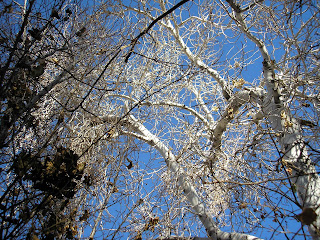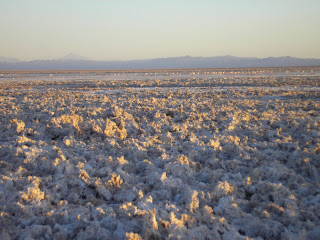On Monday night, we took the Tour of the Night Sky, something that I had really been looking forward to since I have always been drawn to astronomy. Basically, you take a small bus to this guy's house on the outskirts of San Pedro, where he has eight different telescopes set up in his yard. He explained to us simple astronomical facts about how the earth, the rest of the planets, and our galaxy are situated relative to the rest of the universe. He showed us how to use the constellation of the southern cross to find the direction south (take four and a half of the lengths of the long arm of the cross in the direction the cross points to the horizon and there it is). He showed us the closest star to Earth. I learned that all the stars we can see with the naked eye are in our galaxy. He told us lots of other cool stuff that I forgot already, too.
Then, we were set free to look through all the telescopes. We saw Mars, which was a bit of a letdown since it was really far away and only appeared as a yellow splotch of light. We saw a dying star, which looked similar to Mars but less bright, and a nebulae, which is a star being born. It looks like a pocket of mist, and apparently that is all the material starting to coalesce into a star. We looked at several different views of the moon. We looked at Saturn, and it was so clear you could see the rings. We looked at Jupiter, which you could see with the naked eye as the brightest light in the sky besides the moon. Under the telescope, we could see its red stripes and three of its moons! That was perhaps my favorite part. Another really cool view was of this amazing star cluster. Viewed through one of the telescopes, it looked like a blur in the sky. Then, we looked at it through a more powerful telescope, and it was like an explosion of stars. There were so many! I spent a lot of time looking at the cluster. It was fascinating.
We were able to take photos of the moon through one of the telescopes with our digital cameras.
 After the telescope time, we spent some time looking at constellations. Our guide pointed out many of the well known and lesser known constellations we could see, and explained why they northern hemisphere and southern hemisphere see different skies. We also learned the myth of Jupiter, Orion and the Scorpion (one of the many constellations our guide pointed out to us). Apparently, Jupiter (Zeus) was mad that Orion and the Scorpion kept fighting, so he banished them to opposite sides of the sky. So, when you see the Scorpion, you will never see Orion because he is on the other side of the world. We also learned about the different names and images different ancient cultures saw in the constellations. It was pretty interesting. After our constellation-gazing, we went into a room with two rings of chairs situated around a table of candles. The roof was open so you could look up and see they stars. We drank hot cocoa and talked more about astronomy. I was in love! I wished my brother and dad had been there with me!
After the telescope time, we spent some time looking at constellations. Our guide pointed out many of the well known and lesser known constellations we could see, and explained why they northern hemisphere and southern hemisphere see different skies. We also learned the myth of Jupiter, Orion and the Scorpion (one of the many constellations our guide pointed out to us). Apparently, Jupiter (Zeus) was mad that Orion and the Scorpion kept fighting, so he banished them to opposite sides of the sky. So, when you see the Scorpion, you will never see Orion because he is on the other side of the world. We also learned about the different names and images different ancient cultures saw in the constellations. It was pretty interesting. After our constellation-gazing, we went into a room with two rings of chairs situated around a table of candles. The roof was open so you could look up and see they stars. We drank hot cocoa and talked more about astronomy. I was in love! I wished my brother and dad had been there with me!The next day Lukas, Megan and I took a tour out into the Salar de Atacama. We made several stops along the way and ended up at a lagoon in the heart of the Salar to see flamingos!
On our drive, gazing out into the desert landscape, we saw a small herd of llamas running at full speed through the brush. It was an incredible sight. I have only ever seen domesticted llamas, fenced in on farms. It was like, where are the fences and feed troths? They run in a straight line, following the leader. They look pretty solid as they charge across the land.
Although you probably can't tell, those are llamas and wild donkeys.

The first stop we made was to descend into the canyon, as our guide talked about some of the flora and fauna of the area. It was nice to get out and walk. Memorable moments included Lukas pegging me in the back of the neck with a nut in its shell while I tried to take shelter next to an old man, me trying not to kill this little French kid who kept wacking the ground with sticks, and learning about Incan irrigation methods.
A view from down in the canyon.

I thought these trees were cool. Incidentally, Megan was really fun to travel with because she is really into plant biology, and she was always stopping to poke her nose into some sort of bush.
 After our escapades in the canyon, we stopped at the village of Toconao, visited a small church, and then hung out at the plaza. I was continually apalled by the French tourists on our tour, who freely snapped photos around the town with little respect for the local people and the fact that they were being disruptive. For example, there was a kids day camp playing in the middle of the plaza, and this fat-assed old fart walks right up to these sweet kids playing with these colorful streamers, shoves his camera at them, and starts clicking away. I was appalled. You could see the sickening glint in his eye, like he was so pleased with himself for getting a perfect shot of the "native" children. I almost vomited all over him.
After our escapades in the canyon, we stopped at the village of Toconao, visited a small church, and then hung out at the plaza. I was continually apalled by the French tourists on our tour, who freely snapped photos around the town with little respect for the local people and the fact that they were being disruptive. For example, there was a kids day camp playing in the middle of the plaza, and this fat-assed old fart walks right up to these sweet kids playing with these colorful streamers, shoves his camera at them, and starts clicking away. I was appalled. You could see the sickening glint in his eye, like he was so pleased with himself for getting a perfect shot of the "native" children. I almost vomited all over him.After our short time in Toconao, we headed out to the Salar de Atacama. The Salar was formed by giant, ancient, inland salt lakes that dried up and left behind beds of salt and pockets of mini salt lakes. The salt lakes are the habitat of brine shrimp, which is the main diet of flamingos. For this reason, the Salar de Atacama is home to large flocks of flamingos. We rocketed out to the flamingo viewing area on a road of salt that looked like compacted snow.
Here are the salt fields. They are not perfectly white because, in the desert climate, dust is blown onto the salt, rendering it brownish in hue.

A closeup of the salt.
 Pretty!
Pretty! 
The sun cast a golden glow on the salt formations.
 Those light pink dots in the streak of water at the horizon line are flamingos, I swear!
Those light pink dots in the streak of water at the horizon line are flamingos, I swear!
The Salar de Atacama at sunset.

As we were watching the sun set, three flamingos flew right over our heads! The photo makes them seem much farther away, but they were so close we could see the black beaks and the black and magenta feathers under their wings. Their bodies were light pink. They look so goofy flying with their spindly legs and necks outstretched, the big horns of their beaks pointing the way for their giant flapping wings.

The three pals at the Salar.

Flamingos at sunset!

 I loved our visit to the Salar. The landscape was so bizarre, and to see spots of pink in the desolation of the desert was amazing. I thought about my mom a lot, and how she would just love to get out there and start snapping pictures of all the wildlife!
I loved our visit to the Salar. The landscape was so bizarre, and to see spots of pink in the desolation of the desert was amazing. I thought about my mom a lot, and how she would just love to get out there and start snapping pictures of all the wildlife!
No comments:
Post a Comment